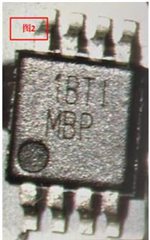- Ask a related questionWhat is a related question?A related question is a question created from another question. When the related question is created, it will be automatically linked to the original question.
This thread has been locked.
If you have a related question, please click the "Ask a related question" button in the top right corner. The newly created question will be automatically linked to this question.
Hello:
Batch 2221 LM2904DGKR abnormal description: After the main control chip LM5026 of the whole machine detects a fault, the RES output (internal current source current is 7.5-12.5ua) charges the C126 capacitor with a voltage of 2.5V, and pin 3 of IC104 (LM2904DGKR) detects this voltage and compares it with pin 2 (1.17V ) for comparison, and output a high level to the subsequent circuit. When the ambient temperature is 100 ℃, the leakage current of pin 3 is large, so the voltage here cannot rise. Eventually lead to the failure of the functional circuit here. After changing to batch 2144, the input signal level is normal and the circuit works. The partial schematic diagram of the circuit is shown in Figure 1, in which IC104 is the device LM2904DGKR.

Waveform comparison
Ambient temperature 100℃
CH2 abnormal 2221 batch 3 pin (IN+) to 4 pin (GND) waveform as shown in the figure

The normal 2144 batch 3-pin (IN+) to 4-pin (GND) waveform is shown in the figure

After scanning, the customer found that the silk screen and internal circuit diagrams of the two batches of materials were different.
2221 batch silk screen, and DPA diagram, as follows


Other batches of 2144 batches of silk screen and DPA pictures are as follows


Please help confirm,Thanks!!!
Hey Jimmy,
Could you provide the stickers on the reels from the devices? Please include both the 2221 and 2144 batches. Note your max Ib for LM2904 is 500nA, which seems to be much smaller than the current you are charging the 2.5V on the cap with.
What are the values of R160 and R161?
Best,
Jerry
Hi Jerry:
Thank you for your reply
1、Here are the two stickers on the reels from the devices include both the 2221 and 2144 batches. After scanning, the customer found that the silk screen and internal circuit diagrams of the two batches of materials were different.
Would you please help explain this difference,Thanks!!!
2、For the schematic diagram, R160 is 30k and R161 is 4k,Customer Feedback This is a mass production project,Except for batch 2221, other batches are normal.
Would you please check the schematic diagram for any problems and points that need improvement, Thanks!!!


Hey Jimmy,
The difference between the two devices is 2221 is post-PCN material. The customer should have been provided the PCN for the device, or if purchasing through a distributor, the distributor should have sent the customer a PCN. Below is an example of what this would look like.
https://media.digikey.com/pdf/PCNs/Texas%20Instruments/PCN20210720001.1.pdf
The explanation of high input bias current doesn't quite make sense. Post-PCN, the device should have lower input bias current.
I have the following questions:
Best,
Jerry
Hi Jerry:
1. PIN3 is directly connected to the RES pin of the main control chip LM5026
2. VCC is 11V
3. The output of PIN1 is a resistance network. The specific connection method is shown in the circuit diagram, and the resistance value of the resistance network is:
R141=45.3K; R142=22.6K; R140=0 OHM; RT100=0.47K; R148=3.01K;
Hello Jimmy,
The LM5026 makes the pin 3 input; the op amp doesn't do that.
Is pin 3 waveform red? What is blue waveform?
Hey Jimmy,
My mistake, I meant to ask about PIN2 of the amplifier. Also with an 11V supply, your resistor divider is not to 1.17, it's to 1.29V. Are you sure there aren't any other components causing an error? I'm trying to simulate your issue but can't seem to recreate the issue. Also, why is there a pull-up resistor to VCC (R141) a pull-up is needed for the LM2903, but this is the LM2904, which is an op amp. I've attached the simulation for reference.
Please note, I had some difficulty with the LM2904 model, so I used the LM2904B model which should yield similar performance.Jimmy_LM2904.TSC
Best,
Jerry
Hello Jerry:
1) 1.17V is measured by an oscilloscope (with errors), and the value of PIN2 is theoretically calculated to be 1.29V;
2) VCC supplies power to RT100 in the resistor network through the R141 resistor; (over-temperature protection function circuit)
Hey Jimmy,
Could you label which of the traces on the oscilloscope correspond to which pin? Additionally, is the input going negative on the device? You cannot exceed the negative supply rails on the LM2904, this will cause the output to phase invert.
Best,
Jerry
Hi Jerry:
PIN2 is the 11V power supply, and PIN1 is the RES of the main control chip LM5026, which can rule out the possibility of negative voltage.
Hi Ron:
Customers say PIN2 has no negative voltage.
This picture only shows the difference between the 2221 and 2144 batches LM2904
Customer found some problems between 2 batches and then do some experiment
The picture show that customer test 3-pin (IN+) to 4-pin (GND) waveform for 2 batches under ambient temperature 100℃.
abnormal voltage

normal voltage

When the ambient temperature is 100 ℃, the leakage current of pin 3 is large, so the voltage here cannot rise. Eventually lead to the failure of the functional circuit here.
Jimmy,
Can you specify what line corresponds to what pin? Is the red line Pin 3 or Pin 1? Please say which pin corresponds to each line from the oscilloscope captures.
Best,
Jerry